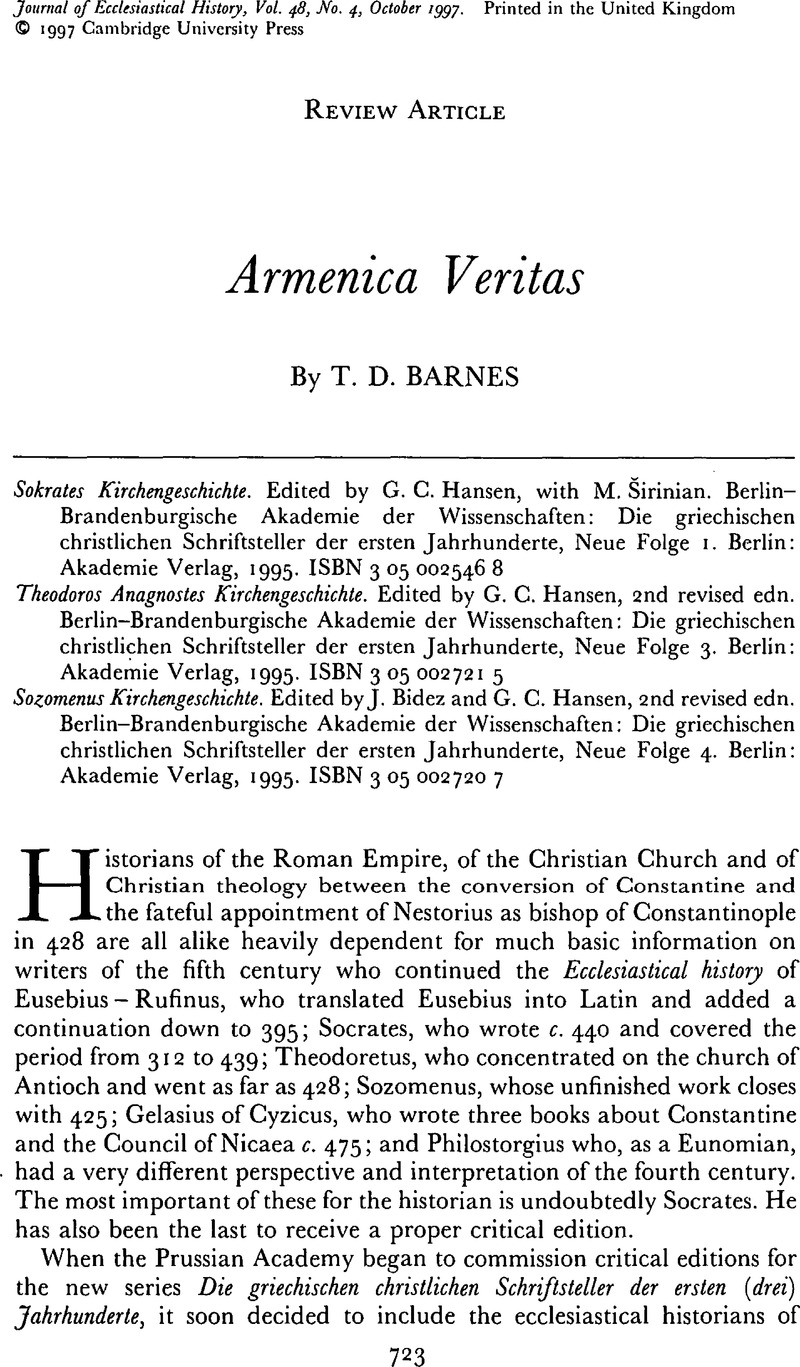No CrossRef data available.
Article contents
Armenica Veritas
Published online by Cambridge University Press: 06 February 2009
Abstract

- Type
- Review Article
- Information
- Copyright
- Copyright © Cambridge University Press 1997
References
1 Conybeare, F. C., ‘Emendations of the text of Socrates Scholasticus’, Journal of Philology xxxiii (1914), 208–37Google Scholar; ‘A collation of the history of Socrates Scholasticus, books IV–VII, with the old Armenian version and the Latin version of Epiphanius Scholasticus as preserved in the Historia tripartita of Cassiodorius’, ibid, xxxiv (1915), 47–77.
2 Hanslik, R., CSEL lxxi (1952), p. xviGoogle Scholar: ‘Waltarius Jacob ex 137 codicibus a se collatis sex classes distinxit, quarum prima in textu constituendo utendum erat, ceterae autem respici non debuerunt. Sed prima classis 27 codd. continens in tres familias, quarum codices artius inter se connexi sunt, dividi potest. Primae igitur familiae optimi codices sunt Neapolitanus N et Leidensis L, secundae Leningradensis C, tertiae Carnutensis A et Casinensis M, quorum vetustissmus codex C initio saec. IX, ceteri saec. X (praeter codicis M posteriorem partem) scripti sunt. Jacob autem omnes ex uno eodemque archetypo fluxisse sibi persuasit. Ego ipse quidem cautius dixerim eos ad archetypum prope accedere. Nihilominus autem ex unaquaque familia optimo codice adhibito et fontibus Graecis passim accurate comparatis historiae tripartitae textus omnibus fere locis sanari potest, si quis non solum linguam Latinam Cassiodori aetatis respiciet, sed etiam Epiphanium saepe ad verbum vertentem ne ipsum quidem intellexisse, quae scripsisset, concedet.’ Inevitably, Hanslik employed Hussey's text of both Socrates, and Sozomenus, (London 1860)Google Scholar.
3 Publ. by Halkin, F., Douze récits byzantins sur saint Jean Chrysostome, Brussels 1977, 69–285Google Scholar.
4 George knows both versions of the long passage 6. 11. 9–20, which Hansen prints in parallel as alternatives both penned by Socrates (pp. 329–33).
5 Širinian, M. S., ‘Ricerche sulla Storia ecclesiastica di Socrate Scolastico e sulle sue versioni armene’, Annali di ca' Foscari. Rivista della Facoltà di lingue e letterature straniere dell'Università di Venezia xxxiii (1994), 151–67Google Scholar.
6 The text offered by the Greek manuscripts in 1. 6. 1 appears to reflect a conscious attempt to emend a corrupt exemplar in which the original verb exekaieto had accidentally dropped out.
7 Hansen argues briefly and effectively that the transmitted chapter headings do not come from Socrates's, own hand, but have been added by a ‘Late Antique editor’ (p. lx)Google Scholar.
8 For example, Wickham, L. R., Cyril of Alexandria: select letters, Oxford 1983, p. xiiiGoogle Scholar. He deduces that ‘the contested election made his position predictably insecure in a city prone to conflict and violence where not even bishops were safe from lynching’ (p. xvi).
9 The existence of the work was disproved by Schwartz, E., Gesammelte Schriften, iii, Berlin 1959, 77–82 (first publ. 1904)Google Scholar.
10 For example, Hanson, R. P. C., The search for the Christian doctrine of God: the Arian controversy, 318–81, Edinburgh 1988, 307–8Google Scholar.
11 On the significance and political context of Constans's letter see now Barnes, T. D., Athanasius and Constantius: theology and politics in the Constantinian empire, Cambridge, Mass. 1993, 89Google Scholar.
12 I have detected only one lapse from the highest standards of scholarship: the neuter ‘gnorimon …touto …katastan’ (7. 16. 5) is construed as a ‘nominativus absolutus’ (361. 22/23 app., 501) instead of an accusative absolute.
13 See the admirable survey by Zuckerman, C. and Stone, M. E., A repertory of published Armenian translations of classical texts, 2nd edn, Jerusalem 1995Google Scholar.
14 For information and advice, I am much indebted to Michael Redies and my Toronto colleague Douglas Hutchinson – whom Dr ŠSirinian is assisting in the preparation of a critical edition of the pseudo-Aristotelian On virtues and vices.




